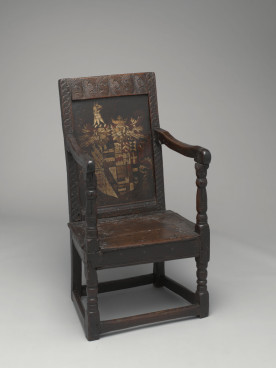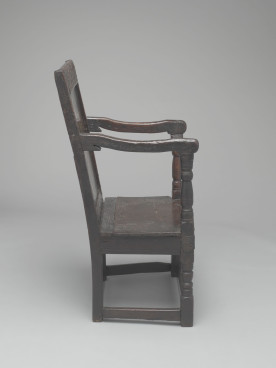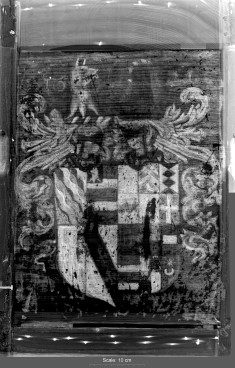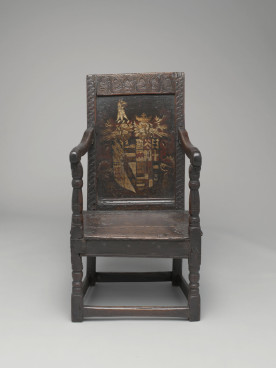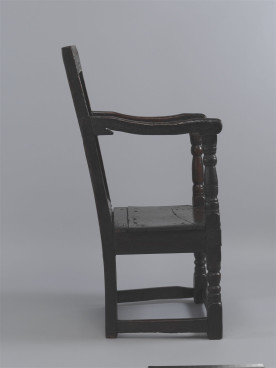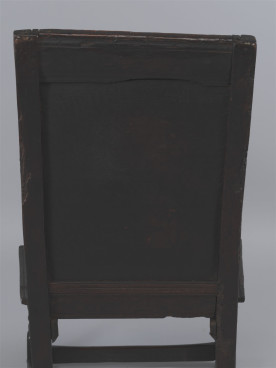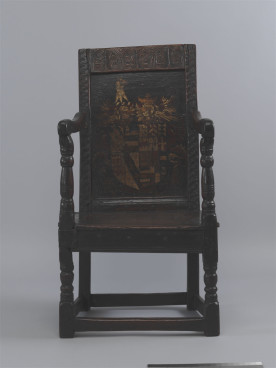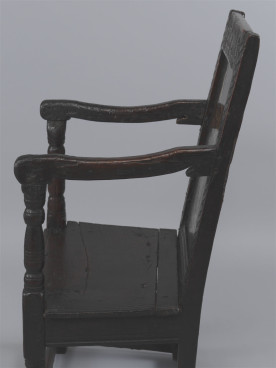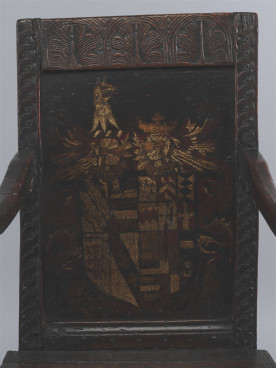Armchair, c.1590–1621
Oak
The back is painted with the arms of Sir Richard Wilbraham of Woodhey, Cheshire, created baronet in 1621. The date ‘1621’ on the chair back has been obscured by dirt and wear.
Adam Bowett Catalogue 14/08/2012
Description
A joined oak armchair, c. 1620-30. The rectangular back has a single large panel painted with the crest of Sir Richard Wilbraham, within a frame of carved guilloche uprights and a lunette carved crest rail, the downcurved arms resting on baluster supports. The boarded seat has a lightly moulded edge, on moulded rails and squat baluster legs joined by plain stretchers with block feet.
Dimensions
H: 39 ¼ “ (100cm) Seat height: 15 ½ “ (39cm) W: 21 ¾ “ (55cm) D: 20” (51cm)
Materials
Oak
Dating
1590-1621
Construction
Mortise-and-tenon construction throughout, all joints double pegged, except at stretcher level. The panel is housed in a groove ploughed in the frame and the back of the panel has been chamfered on all four sides to reduce the board sufficiently to fit the grove The panel is a single piece of fast-grown wood, with the grain running from side to side.
Condition
The chair has been heavily used; almost every exterior surface is abraded and worn, many joints are split/damaged and all this is consistent with use over along period of time. There are many areas of sapwood which have suffered worm damage as well as physical damage. The left arm has been removed and re-fixed with floating tenons. The joint between the left side seat rail and the back post has been reinforced with an iron brace fixed with nails. Many joints have been re-pegged. The frame has been reinforced below the seat with two fore-and- aft oak battens fixed with handmade nails and evidently of some antiquity.
The seat has evidently been lifted and re-fixed several times but it appears to be original. It is in two parts, a wide front board and a narrow board to the rear. Although of different thicknesses and of differing colour underneath, both appear to be original. This is evident from the edge moulding applied to the top of the seat, which is consistent for both pieces.
There are signs of glue blocks having been fixed to the undersides of the seat around the edges, and there is a row of three nail holes towards the back edge of the front seat board. These once fixed a batten underneath the seat, whose outline can just be discerned on the underside. There is also a large hole towards the front right of the seat board whose purpose is unclear.
The back of the chair has slim oak batten, recently applied, just above the lower back rail. This almost certainly serves to close the gap created by shrinkage of the back panel.
There are rows of upholstery tacks and tack holes on the top rail, the front of the lower back rail, on both sides of the arms and around the seat on three sides. These indicate an upholstery covering was applied to the back, seat and arms at some time, and probably account for the survival of the paintwork.
Additional Remarks
The dating of this chair is problematic, the frame could plausibly be late sixteenth century, but the crest cannot be earlier than 1621. This raises the question of whether the crest and the chair were coeval or whether the crest was added later. The arms are those of Sir Richard Wilbraham Bart. whose family seat was at Acton, in Cheshire.
17th century chairs with blank (i.e. uncarved) back panels are nor uncommon. If the painting on this chair is original, it raises the intriguing possibility that many or all such blank panels were once painted.
References
Numerous panel-back armchairs with both plain and carved panels are illustrated in Chinnery (1979) and Jellinek (2009).
Provenance
Purchased from Tobias Jellineck, October 2001


